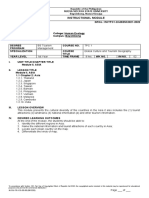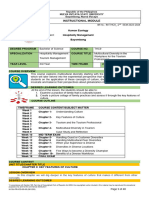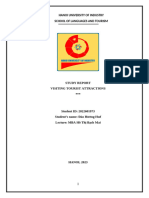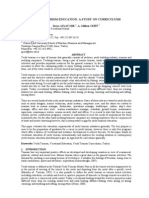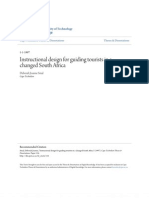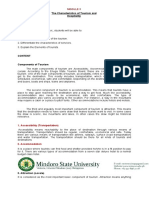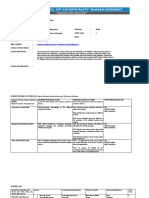Advance Tour Guiding
Advance Tour Guiding
Uploaded by
James LobhoyCopyright:
Available Formats
Advance Tour Guiding
Advance Tour Guiding
Uploaded by
James LobhoyOriginal Title
Copyright
Available Formats
Share this document
Did you find this document useful?
Is this content inappropriate?
Copyright:
Available Formats
Advance Tour Guiding
Advance Tour Guiding
Uploaded by
James LobhoyCopyright:
Available Formats
Republic of the Philippines
NUEVA VIZCAYA STATE UNIVERSITY
Bayombong, Nueva Vizcaya
INSTRUCTIONAL MODULE
IM No.: ECOTOUR24-2S-2021-2022
College: Forestry, Environment and Resources Management
Campus: Bayombong
DEGREE PROGRAM BSECO COURSE NO. ECOTOUR 24
SPECIALIZATION COURSE TITLE Tour Guiding and Escorting
YEAR LEVEL 3 TIME FRAME 3 hrs WK NO. 1 IM NO. 2
I. UNIT TITLE/CHAPTER TITLE
Unit 1. Introduction to Tour Guiding
II. LESSON TITLE
Introduction to Tour Guiding
III. LESSON OVERVIEW
Unit 1 introduces the learners to tour guiding as a profession. It provides a discussion on the core
concepts in tour guiding services, including the definition of tour and tour guiding. The unit likewise
describes the types of tour guides in the past and at present, as well as the career opportunities in tour
guiding.
IV. DESIRED LEARNING OUTCOMES
At the end of the lesson, the students should be able to explain the basic concepts in tour guiding
services, identify the roles of a tour guide, discuss the history of tour guiding in the world and in the
Philippines. Explore opportunities for tour guiding services as a career and discuss the relevance of the
course.
V. LESSON CONTENT
Lesson 2. History of Tour Guiding
History of Tour Guiding
The roles that tour guides play have changed over time. Zenaida Cruz (2008) provides an
account of the evolution of these roles throughout history.
Ancient Times
Tour guides have been around since the ancient times when travelers found the need for guides
who could help them in their journey. The information that guides provide were prized by many
historians, including Herodotus who valued guides who could recite “with great authority, dates,
dialogues, and other specifics about people who had lived hundreds of years ago.” Homer’s literary
piece Iliad mentioned guides who showed the battlefields and the shores where the Greek ships
arrived. (Cruz 2008, 13).
NVSU-FR-ICD-05-00 (081220) Page 1 of 4
“In accordance with Section 185. Fair Use of a Copyrighted Work of Republic Act 8293, the copyrighted works included in this
material may be reproduced for educational purposes only
and not for commercial distribution”
Republic of the Philippines
NUEVA VIZCAYA STATE UNIVERSITY
Bayombong, Nueva Vizcaya
INSTRUCTIONAL MODULE
IM No.: ECOTOUR24-2S-2021-2022
Dark-Middle Ages
With the fall of the Roman Empire, this period is regarded as a dangerous time in European
history. Thus, the period emphasized the guides’ role as safety escorts for travelers, including pilgrims
and businessmen.(Cruz 2008, 14)
Renaissance
During the Renaissance, guides took a more demanding role – that of an educator or a mentor
in addition to the role of protector- when the Grand Tour became a fashion as a rite of passage for sons
of well-to-do Europeans. A carefully appointed guide served as the young man’s tutor and chaperone
as he went on a journey through a prescribed route from England through France, Germany, Austria,
Switzerland, to Italy, which was the final destination. After which, the student would return and be
welcomed home as a gentlemen. (Cruz 2008, 14)
Modern Age
No evidence exists of organized training for guides before the 20 th century other than the
company training given by the Thomas Cook Travel Agency (Wei Hu 2007). England is one of the first
countries to regulate and train guides when authorities were prompted by the guides’ aggressive
competition with each other for the business that tourists bring in the 1930s. today, many countries train
and accredit guides to maintain standards and professionalism.
Nonetheless, even though the guide’s roles have evolved over time, the history of the tour
guiding profession still confirms the roles that tour guides play even to this day: as communicator,
educator, and shepherd who takes care of the tourists.
Career Opportunities in Tour Guiding
How can one become a tour guide nowadays? In the Philippines, the Department of Tourism
(DOT) (1995) defines a tour guide as “an individual who guides tourists, both foreign and domestic, for
a fee.”
According to the DOT’s Rules and Regulations to Govern the Accreditation of Travel and Tour
Services (1995), the requirements for the issuance of accreditation to a tour guide are the following:
1. Proof that the applicant has passed a seminar for tour guides duly conducted by the Department, or
other agencies duly authorized by the Department to conduct the seminar.
2. Certificate of good health issued by any duly accredited government physician
3. Clearance from the National Bureau of Investigation (NBI)
4. In the case of alien applicants, valid visa from the Bureau of Immigration and the proper permit from
the Department of Labor and Employment (DOLE)
5. Mayor’s permit or municipal license
6. Latest Income Tax Return
7. Such other documents that DOT may require from time to time
The Mayor’s permit is necessary because it identifies the place where the tour guide works. As
mentioned in the WFTGA definition, a tour guide’s qualification should be “area-specific”.
Types of Tour Guide
Nowadays, there are different types of employment opportunities as tour guides. Here are the
types of guide based on how they earn:
NVSU-FR-ICD-05-00 (081220) Page 2 of 4
“In accordance with Section 185. Fair Use of a Copyrighted Work of Republic Act 8293, the copyrighted works included in this
material may be reproduced for educational purposes only
and not for commercial distribution”
Republic of the Philippines
NUEVA VIZCAYA STATE UNIVERSITY
Bayombong, Nueva Vizcaya
INSTRUCTIONAL MODULE
IM No.: ECOTOUR24-2S-2021-2022
Employed Guides
Employed guides are those employed by a company who earn a regular wage whether there
are clients or none. These companies include the government, private travel agencies, museums, and
industries that run their own tour facilities. Based on an average of 16 tours per month, a tour guide in
the Philippines can earn P16,000 to P40,000 per month. Tour guides can also earn from tips or
monetary gifts from clients in addition to the regular wage, if the employer allows. Tips can range from
P100 to 100USD per tour.
Freelance Guides
Freelance guides are entrepreneurs who, like other businessmen, depend on the influx of
clients to earn. These are self-employed guides who make and sell their own tours.
Docile or Volunteer Guides
Docile or volunteer guides are unemployed guides who are mostly hobbyists such as retirees
and environmental advocates. They earn non-monetary rewards such as friendship, experience, and
cultural exchange. Some volunteer guides accept tips too.
Here are the types of guide based on their specialization:
Plant Guides
Plant guides are employed by corporations, usually as part of the public relations department.
They conduct tours in the company’s plant or factory, with the primary aim of uplifting the company’s
public image by educating visitors about their business goals and operations. In a way, they are like
museum guides who specialize in a particular collection.
Adventure Guides
Adventure guides are, first and foremost, hobbyists who love a particular sporting acitivity and
introduce this activity to the tourists. They require a special skill set, including those related to guest
safety. In the Philippines, for instance, cave guides undergo an accreditation process that is different
from that of a city guide.
City Guides
City guides specialize in a particular city or province. They guide tourists to see the city’s places
of interest while providing information on its history and heritage, and their relevance to the country’s
socio-economic development. City guides may be freelancers, government employees, travel agency
employees, or volunteers.
Other types of guides include golf guide, shopping guide, special interest guide, and cultural and
heritage guide, all of whom specialize in a particular activity, collection or location.
Relevance of the Tour Guiding Course
Tour guiding can be a rewarding occupation, especially in areas frequented by tourists. Some
tour guides earn enough from tips alone. There are tour guides in Manila and Cebu who regard tour
guiding as a lifelong career. They have raised their families through tour guiding proceeds. Some have
risen up the corporate ladder and rose to executive positions in their companies.
NVSU-FR-ICD-05-00 (081220) Page 3 of 4
“In accordance with Section 185. Fair Use of a Copyrighted Work of Republic Act 8293, the copyrighted works included in this
material may be reproduced for educational purposes only
and not for commercial distribution”
Republic of the Philippines
NUEVA VIZCAYA STATE UNIVERSITY
Bayombong, Nueva Vizcaya
INSTRUCTIONAL MODULE
IM No.: ECOTOUR24-2S-2021-2022
Whichever path they choose, ,most tour guides remain steadfast in their dedication to the
profession for the non-monetary gratifications, such as meeting people and learning about other
people’s cultures as well as their own.
Tour guides play an important role in the multibillion-dollar tourism industry. Tourism cannot
progress without trained manpower. As professionalism is one of the core elements of tour guiding, it is
imperative to provide a well-defined program for training aspiring tour guides. The inclusion of tour
guiding as one of the specialization tracks in the K to 12 curriculum in the Philippines is therefore a
significant advancement toward harnessing the potentials of tourism growth in the country.
II. EVALUATION (Note: Not to be included in the student’s copy of the IM)
III. LEARNING ACTIVITIES
Answer the question in your own words.
1.Based from what you read about the history, can you summarize important details how tour guiding
started.
Note: Please upload, submit, or turn in your work to our Google classroom.
IV. ASSIGNMENT
None
V. REFERENCE/S
Angeles, Marie V. (2021). Global Culture and Tourism Geography. Sta. Cruz Manila
NVSU-FR-ICD-05-00 (081220) Page 4 of 4
“In accordance with Section 185. Fair Use of a Copyrighted Work of Republic Act 8293, the copyrighted works included in this
material may be reproduced for educational purposes only
and not for commercial distribution”
You might also like
- O'Neill V Ratajkowski OrderDocument31 pagesO'Neill V Ratajkowski OrderTHROnlineNo ratings yet
- Chapter 2 - Global Culture and Tourism GeographyDocument9 pagesChapter 2 - Global Culture and Tourism GeographyAira Leigh Suguitan100% (2)
- Module Cruise 2021 Updated PDFDocument33 pagesModule Cruise 2021 Updated PDFKatrina Javier100% (1)
- Introduction To Tour GuidingDocument32 pagesIntroduction To Tour GuidingEsmeraldo Alcaraz100% (6)
- 1752 - التدريب الأسس والمبادئ - صلاح صالح معمار PDFDocument100 pages1752 - التدريب الأسس والمبادئ - صلاح صالح معمار PDFSalahEddineLeberraraNo ratings yet
- Tour GuidingDocument3 pagesTour GuidingJames LobhoyNo ratings yet
- Instructional Module: Republic of The Philippines Nueva Vizcaya State University Bayombong, Nueva VizcayaDocument3 pagesInstructional Module: Republic of The Philippines Nueva Vizcaya State University Bayombong, Nueva VizcayaJames LobhoyNo ratings yet
- Federal UniversDocument25 pagesFederal UniversAbiodun OladipupoNo ratings yet
- Introduction To Tourism For 9 THDocument82 pagesIntroduction To Tourism For 9 THKalsoom GhazanfarNo ratings yet
- Chapter 2 THC9Document7 pagesChapter 2 THC9Shieri Mae PaulinoNo ratings yet
- Chapter 1 THC9Document11 pagesChapter 1 THC9Shieri Mae PaulinoNo ratings yet
- Name of The Program Course Title Course Code Prerequisite/ Co-Requisite Course Unit Course OutcomeDocument14 pagesName of The Program Course Title Course Code Prerequisite/ Co-Requisite Course Unit Course Outcomemikacenteno0407No ratings yet
- Hyflex Module 4 Week 7 - HTM 101 Tourism and Hopsitality Activities 2-26-24Document12 pagesHyflex Module 4 Week 7 - HTM 101 Tourism and Hopsitality Activities 2-26-24mikacenteno0407No ratings yet
- Final Exam Assignment: Major: Introduction To TourismDocument18 pagesFinal Exam Assignment: Major: Introduction To TourismTrang ThuỳNo ratings yet
- Introduction To Tourism XDocument91 pagesIntroduction To Tourism XsadiewamboiNo ratings yet
- Baos Caos Tuyen DiemDocument21 pagesBaos Caos Tuyen DiemĐào Hương HuếNo ratings yet
- Module 2 Macro Perspective of Tourism and HospitalityDocument52 pagesModule 2 Macro Perspective of Tourism and HospitalityRoy CabarlesNo ratings yet
- IM Macropersperctive of Tourism and Hospitality Complete 2024 2025Document59 pagesIM Macropersperctive of Tourism and Hospitality Complete 2024 2025Cessie MikeeNo ratings yet
- A Seminar Project Report ON ": Tourism"Document29 pagesA Seminar Project Report ON ": Tourism"Geetanajli GirdharNo ratings yet
- ABTT1Document25 pagesABTT1CJ Mercado PlazaNo ratings yet
- TH 1 and 2Document7 pagesTH 1 and 2shizea tokioNo ratings yet
- Module 4-Tourism ProductDocument17 pagesModule 4-Tourism ProductmaeganericapNo ratings yet
- Prelim and Midterm Modular THC 7Document12 pagesPrelim and Midterm Modular THC 7cyrealcuevaNo ratings yet
- THC1101 Module 1 Topics 1 and 2Document11 pagesTHC1101 Module 1 Topics 1 and 2YuGenNo ratings yet
- TourismDocument22 pagesTourismMayur JoshiNo ratings yet
- Local Guiding Services: K To 12 Basic Education CurriculumDocument34 pagesLocal Guiding Services: K To 12 Basic Education CurriculumMistekee Maramag100% (4)
- Тези НУЦЗУ 2016 RitchieDocument3 pagesТези НУЦЗУ 2016 RitchieUlil FahmiNo ratings yet
- Implementation of Green Tourism Concept On Glamping Tourism in BaliDocument5 pagesImplementation of Green Tourism Concept On Glamping Tourism in BaliAlex AbelNo ratings yet
- Factors That Affects The Service Quality of Accredited Tour Guides in Metro ManilaDocument31 pagesFactors That Affects The Service Quality of Accredited Tour Guides in Metro ManilaMerlito BabantoNo ratings yet
- Overview of The Travel and Tourism IndustryDocument18 pagesOverview of The Travel and Tourism IndustryKimberly PistachioNo ratings yet
- Hospitality and Tourism 110Document52 pagesHospitality and Tourism 110king coNo ratings yet
- Courseoutline 412Document4 pagesCourseoutline 412kelvinNo ratings yet
- Yacht Tourism in TurkeyDocument8 pagesYacht Tourism in TurkeyandjeomajkinNo ratings yet
- Project Report-Pts - 06: KUONI BRAND: Expect MoreDocument54 pagesProject Report-Pts - 06: KUONI BRAND: Expect MoreRicky FernandoNo ratings yet
- Module 2&3Document6 pagesModule 2&3Rana VergaraNo ratings yet
- Tour Guide Syllabus: Quality Improvement For The Cross-Border Tourism in The Danube Delta (Romania, Ukraine and Moldova)Document11 pagesTour Guide Syllabus: Quality Improvement For The Cross-Border Tourism in The Danube Delta (Romania, Ukraine and Moldova)eltonNo ratings yet
- Fieldtrip Report Victoria MarvellousDocument7 pagesFieldtrip Report Victoria MarvellousAbiodun OladipupoNo ratings yet
- Dissertation On TourismDocument131 pagesDissertation On TourismEd StewartNo ratings yet
- TLE 026 Home Economics Literacy Module 7Document21 pagesTLE 026 Home Economics Literacy Module 7Ivy Chezka HallegadoNo ratings yet
- Syllabus in Philippine Culture and Tourism GeographyDocument8 pagesSyllabus in Philippine Culture and Tourism GeographyCrizz Oracion MedijaNo ratings yet
- 8l Tourism Lesson PlanDocument10 pages8l Tourism Lesson PlananntoinesiaNo ratings yet
- Unit 1 - Introduction To TourismDocument21 pagesUnit 1 - Introduction To TourismDaryl A. Dela CruzNo ratings yet
- FormatDocument5 pagesFormatBituin LynNo ratings yet
- Handbook of On-Job-Training For Tour Guide in Tourism IndustryDocument95 pagesHandbook of On-Job-Training For Tour Guide in Tourism IndustryladintoryoNo ratings yet
- Chapter 9 Edmodo 2Document14 pagesChapter 9 Edmodo 2Xye BreyNo ratings yet
- TPC 2 Tour and Travel Management AM DELEON UpdatedDocument76 pagesTPC 2 Tour and Travel Management AM DELEON UpdatedArjay Solis100% (1)
- Tpc2 ModuleDocument76 pagesTpc2 ModuleArjay SolisNo ratings yet
- Handbook For Tour Guides: Research GateDocument15 pagesHandbook For Tour Guides: Research Gateimrul khanNo ratings yet
- Prototype Lesson Plan Template Travel Services W2Document8 pagesPrototype Lesson Plan Template Travel Services W2Argesil SaysonNo ratings yet
- IM-Muticultural Diversity in The Workplace For The Tourism ProfessionalDocument39 pagesIM-Muticultural Diversity in The Workplace For The Tourism Professionaleugenesantospascua133No ratings yet
- Arun Project Report 6112 BTTM 6th SemDocument48 pagesArun Project Report 6112 BTTM 6th SemArun BhardwajNo ratings yet
- Advantage of EcotourismDocument14 pagesAdvantage of EcotourismNEW HOPENo ratings yet
- The Characteristics of Tourism and Hospitality Learning ObjectivesDocument13 pagesThe Characteristics of Tourism and Hospitality Learning ObjectivesAngela MendozaNo ratings yet
- Module 2Document11 pagesModule 2Vicmar batiancila AltarNo ratings yet
- Adventure TourismDocument14 pagesAdventure TourismPrabath Nilan Gunasekara100% (1)
- Bbaatr 201 SLMDocument186 pagesBbaatr 201 SLMpadmavathiNo ratings yet
- Module-2 TrendsDocument11 pagesModule-2 TrendsKristine Rose D. AgustinNo ratings yet
- Module-Overview of TourismDocument5 pagesModule-Overview of TourismNICOLE ERICA LAPURGANo ratings yet
- Training Module - Competency Standard For Ecotourguides - ENG - July2013Document91 pagesTraining Module - Competency Standard For Ecotourguides - ENG - July2013TOEFL LCDL lcdNo ratings yet
- Philippine Tourism Culture and Geography - REYESDocument12 pagesPhilippine Tourism Culture and Geography - REYESgwendon100% (2)
- Responsible Travel To Natural Areas That Conserves The Environment and Improves The Well-Being of Local PeopleDocument10 pagesResponsible Travel To Natural Areas That Conserves The Environment and Improves The Well-Being of Local PeopleChing Siok ChunNo ratings yet
- None Teaching PersonnelDocument50 pagesNone Teaching PersonnelJames LobhoyNo ratings yet
- Support ServicesDocument27 pagesSupport ServicesJames LobhoyNo ratings yet
- Feasibility StudyDocument13 pagesFeasibility StudyJames LobhoyNo ratings yet
- Physical FacilitiesDocument22 pagesPhysical FacilitiesJames LobhoyNo ratings yet
- ProfessionDocument3 pagesProfessionJames LobhoyNo ratings yet
- Media AnsDocument23 pagesMedia AnsKing PendragonNo ratings yet
- Media and Information Final ExamDocument3 pagesMedia and Information Final ExamShyr R PalmNo ratings yet
- Tuskegee Syphilis Study - The Real Story and BeyondDocument171 pagesTuskegee Syphilis Study - The Real Story and BeyondJSonJudahNo ratings yet
- Articles 1305 1422 PDFDocument34 pagesArticles 1305 1422 PDFLili esNo ratings yet
- Temas de Estructuras Especiales ESTRUCTURAS de TRACCI NDocument50 pagesTemas de Estructuras Especiales ESTRUCTURAS de TRACCI Nmcg883100% (4)
- WALKER, L. L. Language of AmosDocument13 pagesWALKER, L. L. Language of AmosFilipe AraújoNo ratings yet
- Nociones de Derecho Civil y Mercantil 1 To 80Document80 pagesNociones de Derecho Civil y Mercantil 1 To 80lizet100% (2)
- Copyright Quiz AnswersDocument2 pagesCopyright Quiz Answersapi-307337824No ratings yet
- Four Factors of Fair UseDocument3 pagesFour Factors of Fair UsesaihunterNo ratings yet
- Monson, Ingrid (1996) - Saying Something-Jazz Interaction - Chapter6Document24 pagesMonson, Ingrid (1996) - Saying Something-Jazz Interaction - Chapter6Rafael GoncalvesNo ratings yet
- Entertainment Law OutlineDocument14 pagesEntertainment Law OutlineKim BoSliceNo ratings yet
- Plaintiffs Motion For Summary Judgment On Fair Use in Sony v. TenenbaumDocument29 pagesPlaintiffs Motion For Summary Judgment On Fair Use in Sony v. TenenbaumBen Sheffner100% (1)
- Childhood As A Legal Status: Roger J.R. LevesqueDocument16 pagesChildhood As A Legal Status: Roger J.R. LevesqueYanina GutierrexNo ratings yet
- GineersNow HVACR Leaders Magazine Issue 001, Johnson ControlsDocument78 pagesGineersNow HVACR Leaders Magazine Issue 001, Johnson ControlsGineersNowNo ratings yet
- 14-نظريات التنظيمDocument8 pages14-نظريات التنظيمa1h9m8a7d0No ratings yet
- Art Appreciation W&a 8-10Document6 pagesArt Appreciation W&a 8-10cyrusjojieNo ratings yet
- The Dynamics of Reassurance - IJP.074.0275A-pepwebDocument12 pagesThe Dynamics of Reassurance - IJP.074.0275A-pepwebPaola Mrqz SilvNo ratings yet
- Team 12 Moot CourtDocument19 pagesTeam 12 Moot CourtShailesh PandeyNo ratings yet
- Wilson, Evidence of Editorial Division in The Hebrew PsalterDocument18 pagesWilson, Evidence of Editorial Division in The Hebrew Psaltertheoarticles100% (1)
- Cpoyright Issues in Cyber SpaceDocument25 pagesCpoyright Issues in Cyber SpaceChaitanya GhaiNo ratings yet
- Summarized Plagirism ReadingDocument3 pagesSummarized Plagirism ReadingGeorge PandaNo ratings yet
- The Politics of Accommodation and Integration in Democratic StatesDocument23 pagesThe Politics of Accommodation and Integration in Democratic StatesLeya AzfarNo ratings yet
- IPL Finals Copyright and Patent (AY 09-10)Document45 pagesIPL Finals Copyright and Patent (AY 09-10)cmv mendozaNo ratings yet
- Media Rights and Exclusivity of Sports BroadacstingDocument12 pagesMedia Rights and Exclusivity of Sports BroadacstingSAI SUVEDHYA RNo ratings yet
- Akanoc Order Re Injunction and New TrialDocument35 pagesAkanoc Order Re Injunction and New TrialjacoombsNo ratings yet
- Ip Photography PDFDocument12 pagesIp Photography PDFVlynNo ratings yet
- IM NO.: IM-PROFED8-2NDSEM-2020-2021 College of Teacher Education Bayombong CampusDocument9 pagesIM NO.: IM-PROFED8-2NDSEM-2020-2021 College of Teacher Education Bayombong CampusXyra BallesterosNo ratings yet
- Trails 6th GradeDocument5 pagesTrails 6th Gradeapi-200984070No ratings yet

